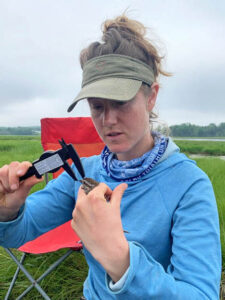
Bacteria from nematodes could be used to kill fire ants, UMaine research reveals
Bacteria-infected nematodes may provide biological control of invasive European fire ants found in Maine, according to a University of Maine-led study.
UMaine scientists found that dead fire ants, Myrmica rubra, in colonies on Mount Desert Island and Orono were infected by nematodes, or roundworms, harboring bacteria, particularly in their digestive tracts. Their findings led them to investigate whether the nematodes killed the ants by transporting bacteria from the soil to the ants, where they may have contributed to ant mortality. They also explored what bacteria communities might be involved.
The researchers found that bacteria species in the Serratia and Pseudomonas genuses were able to be transported by nematodes into ants or other insects they infect, and may be the cause of the fire ant mortality. Many different species of Serratia and Pseudomonas are found in the environment and under the right conditions, they can cause harm to insects, animals or humans, researchers say. They also argue that the life stages and morphology of nematodes may play a role in the attachment and retention of environmental bacteria.
Their findings are published in the journal iScience.
“There is a lot of research left before nematode transmission of bacteria could be used as biological control against ants, but it remains an intriguing possibility,” says lead author Sue Ishaq, an assistant professor of animal and veterinary sciences.
Ishaq and her colleagues say that bacteria found in the digestive tracts of nematodes or on their exterior cuticle could be carried into the bodies of the ants when the nematodes infect their hosts. To test this, they conducted a lab experiment in which they fed fluorescent bacteria to nematodes and then examined the nematodes for signs that fluorescent bacteria could be carried on or in their bodies and into exposed waxworms.
Adult nematodes from the study had high concentrations of bacteria in their digestive tracts, but none on their cuticles, according to researchers. Juvenile nematodes had more on their cuticle than in the digestive tract. In a preliminary assay, the researchers didn’t find that labeled bacteria had transferred into the waxworm larvae, which they say leaves the effectiveness of nematode as a consistent vector for lethal bacteria transmission in fire ants in question. Further study, they say, is necessary to confirm this.

Where nematodes come from, which determines which bacteria communities they access, might also affect their ability to cause fire ant mortality. Local conditions contribute to how bacteria in the environment “grow up,” and some conditions might favor the development of bacteria that are more infectious, Ishaq says. Only nematodes from Breakneck Road in Acadia National Park and Orono, and not the Visitor Center in Hulls Cove, caused ants to die off, presumably because the nematodes harbored bacteria that killed insects, according to researchers.
“The problem with using bacteria as a mode of biological control is that they don’t always act the way you want them to — sometimes they are uncooperative team members,” Ishaq says.
The new study builds on more than a decade of research into possible methods for controlling the invasive ants, which have infested areas across Maine, particularly along the coast, for about 50 years. Their competitive and aggressive nature have made fire ants, named for their painful sting, almost impossible to eradicate, prompting scientists to turn to biological methods.
Eleanor Groden, a recently retired UMaine professor of entomology and a co-author of the latest study, has been at the forefront of UMaine’s investigation of the problem since the mid-2000s, leading multiple studies exploring possible ways to eradicate them. In 2015, she and her colleagues released a study detailing their discovery of a new species of fungi that had killed fire ants in Maine. At the time, however, Groden said “it may be too difficult to reproduce, which would hamper its development as a biological control mechanism.” Additional investigations turned Groden and University of Arizona professor Patricia Stock, who also contributed to the latest study, toward nematodes.
The latest study served as the culmination of research from various scientists, Ishaq says, including Jean MacRae, an associate professor of civil and environmental engineering, and UMaine Honors College alumni Amy Michaud, now a researcher from the University of California, Davis, Jonathan Dumont, now an instructor with Husson University, and others.
Ishaq says she conducted DNA sequencing data analysis from earlier bacterial experiments with UMaine graduate students Alice Hotopp and Samanatha Silverbrand as part of their graduate-level data analysis course. Their work rounded out the investigations so far conducted by the research team, and it was collectively published this year in the iScience report. Typically, Ishaq says she works on the bacteria that associate with mammals.
“I am delighted to have participated in this research, as it gave me a new research perspective on the way that bacteria might interact with insect or animal hosts,” Ishaq says.
Contact: Marcus Wolf, 207.581.3721; marcus.wolf@maine.edu
